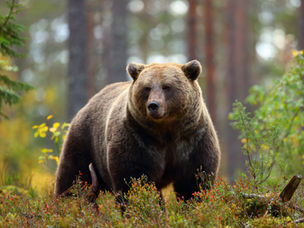top of page
BIG DADDY BLOG


What to Do When You Encounter Animals in the Wild
Learn how to stay safe when encountering animals in the wild. From bears to snakes, follow key tips to react calmly and protect yourself outdoors.
Oct 83 min read


Ultimate Fall + Winter Garage Storage Tips for Fishing Gear
Tips and ideas for fall and winter garage storage for fishing gear.
Oct 14 min read


Best Year-Round Outdoor Sports for Adventurous Outdoorsmen in the Northeast
The Northeast is one of the best regions in America for outdoorsmen who live for adventure. With four distinct seasons, rugged landscapes, and a mix of mountains, rivers, forests, and coastline, there’s no shortage of outdoor sports to enjoy all year long.
Sep 242 min read


How to Get Friends Into Football This Fall
Learn how to get friends into football this fall. With tailgates, seasonal food, and traditions, make game day fun for kids, partners, and friends alike.
Sep 172 min read


Essential Tips for Successful Saltwater Bass Fishing Adventures
Saltwater bass fishing is an exhilarating experience that combines the thrill of the catch with the beauty of the ocean. Whether you're a seasoned angler or a beginner, there are always new techniques and tips to enhance your fishing adventures. In this post, we’ll explore essential tips that will help you reel in those prized saltwater bass.
Sep 102 min read


End of Summer Fishing & Fall Adventures
As the last long days of summer fade into crisp mornings and colorful leaves, there’s no better time to get outside and enjoy the water. Late summer and early fall are prime seasons for anglers - the weather is cooler, the fish are active, and the scenery is unmatched.
Sep 32 min read


The Rise of Outdoor Wellness Retreats: Do They Work?
Explore the rise of outdoor wellness retreats. See how nature, mindfulness, and self-care experiences can improve health and create lasting balance.
Aug 272 min read


Chasing Albies: Mastering False Albacore Fishing on the East Coast This Fall
From August through October, the East Coast comes alive with fast-moving bait balls, diving birds, and one of the most exciting game fish you can catch on light tackle—false albacore, also known as albies or little tunny. Pound for pound, these hard-fighting speedsters are unmatched, and for many anglers, fall means one thing: it’s albie season.
Aug 202 min read


Easy Escapes. A Family & Pet-Friendly Getaway to the Catskills
Looking to escape the heat for a weekend without driving halfway across the country? The Catskills are calling - and they’re closer than you think. Just a 3–4 hour ride from the South Jersey/Philadelphia areas, this scenic slice of upstate New York is packed with adventure that’s perfect for the whole family, furry friends included.
Aug 132 min read


7 Iconic Lighthouses to Visit in the U.S. for National Lighthouse Day
Celebrate National Lighthouse Day with a trip to one of these 7 iconic U.S. lighthouses. Perfect for outdoor lovers who appreciate history, scenery, and adventure.
Aug 62 min read


Conquer New Heights on National Climb a Mountain Day: Discover the Top 5 Must-Do Hikes in the US
Every year on July 30th, adventure seekers and nature lovers gather to celebrate National Climb a Mountain Day. This day is about pushing personal boundaries, enjoying the outdoors, and appreciating the stunning beauty of nature. Whether you’re an experienced hiker or just looking for a fun way to connect with the great outdoors, tackling a mountain hike is a perfect way to honor this day.
Jul 303 min read


How to Handle Bugs in the Outdoors Without Ruining Your Trip
Learn how to handle bugs in the outdoors with smart gear, repellents, and campsite tips so you can enjoy your adventure without constant swatting.
Jul 233 min read


The Evolving Style of Big Daddy Life Fishing Rod Racks
At Big Daddy Life, we’ve always built our rod racks to be more than just functional; they’re a reflection of who you are and how you live. For years, our bold-patterned designs like the US Flag, Blue Camo, and Mahi Print have been fan favorites. And for good reason; they stand out, make a statement, and show pride in what you’re about, whether that’s country, the outdoors, or just a love for eye-catching gear.
Jul 162 min read


The Perks of Wearing UPF Shirts Outdoors: Why Sun Protection Matters
Spending time outside? Whether you're hiking, fishing, golfing, or just enjoying a sunny day, it comes with one major risk: exposure to harmful UV rays. While sunscreen is a solid defense, it’s not always enough. That’s where UPF (Ultraviolet Protection Factor) shirts come in.
Jul 91 min read


What to Do if You Encounter a Bear: Safety Tips for the Outdoors
Not sure what to do if you encounter a bear? Learn how to stay safe while hiking, camping, or fishing in bear country with these must-know outdoor safety tips.
Jul 23 min read


Explore the 5 Incredible Benefits of Our All-American Fishing Rod Racks!
Fishing isn't just a hobby; it’s a thrilling experience filled with excitement and relaxation. Picture yourself casting lines at dawn or reeling in a massive catch during a peaceful sunset. To enhance this experience, having the right gear is crucial. One of the best investments for any angler is a quality fishing rod rack.
Jun 253 min read


How to Install a Rod Rack in 10 Minutes
Looking to get your gear organized fast? Installing your Big Daddy Fishing Rod Racks is a quick, no-stress project you can complete in under 10 minutes. Whether you're mounting on the wall or ceiling, our step-by-step guide will have your rods off the floor and on display in no time.
Jun 182 min read


Top Budget Outdoor Activities That Cost Next to Nothing
Explore budget outdoor activities that bring big fun without the big spend. Perfect for weekend adventures, backyard hangs, and more.
Jun 112 min read


Discover Our Limited Edition Fishing Rod Racks - Crafted in USA
Exciting news awaits you! We have launched a new selection of limited edition fishing rod racks that blend functionality and beauty seamlessly. These racks are crafted with care and come in three stunning colors: Dark Elm, Gray Drift, and White Oak.
Jun 43 min read


Redfish 101: How to Catch These Inshore Powerhouses
Redfish, also known as red drum, are one of the most exciting inshore species to target. With their bronze bodies, tailing behavior, and powerful runs, they offer the perfect challenge for anglers of all levels.
May 281 min read
bottom of page


